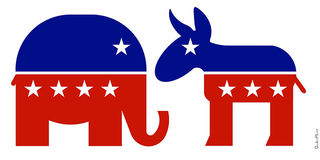Politics
What Does the Political Divide Mean for U.S. Teens?
Teens are either doubling-down on their political views or rejecting politics.
Posted May 27, 2019
American political division has sharply risen over the past 25 years. In the mid-1990s, 17-21 percent of Democratic and Republican adults indicated having “very unfavorable” feelings toward the opposing party. In 2016, this number has risen to more than 55 percent (Pew Research Center, 2016). This growing political division has far-reaching effects on the lives of Americans. In a recent, nationally representative study of 800 American adults, 38 percent reported that politics has caused them stress, and 20 percent indicated that politics has damaged close relationships (Hibbing, Hibbing, & Smith, 2019). An example of this was a recent report published in Science showing that Thanksgiving dinners after the 2016 election were 30-50 minutes shorter when the people attending belonged to opposing political parties (compared to similar political parties), likely due to increased political conflict (Chen & Rhola, 2018).

These are clearly trying times for Americans who are engaged in—or even just aware of—U.S. politics. But what are the implications of the current political climate for the next generation of voters? How will this political divide and increased tension impact teens who are just entering the political arena?
We need to understand how politics impact the lives of youth.
There is a growing body of research from developmental psychologists that highlights how political climates shape teenagers’ political development. Teens experience greater concern about different social issues based on current events. For example, concerns about racial integration were greater among teens during the racial tension of the 1990s, and concerns about the economy grew during the great recession of the late 2000s (Oosterhoff, Wray-Lake, Palmer, & Kaplow, 2019). This suggests that youth are paying attention to current events and are incorporating their experiences into their views about which problems are most troubling.
Not surprisingly, teens’ political development is already being affected by the growing U.S. political polarization. Similar to adults, U.S. teens endorse more extreme political ideologies relative to previous generations, and a growing number of teenagers are identifying as Independent (Twenge, Honeycutt, Prislin, & Sherman, 2016). In other words, teens are either becoming more polarized (similar to many U.S. adults), or they are outright rejecting the current two-party political system.
This increased polarization and rejection of partisanship may have implications for how young people approach politics.
Teenagers who identify as either Republican or Democrat are more engaged in politics—they are more likely to vote, give money to a political candidate or cause, and work in a political campaign—compared to youth without a party identification or those who identify as Independent (Wray-Lake, Arruda, & Hopkins, 2019). Party and candidate organizations play a powerful recruitment role in encouraging members to turn out in elections, connecting people with similar interests and ideologies, and helping individuals develop their political identity (Levendusky, 2009).

If partisanship connects people to the political system, then these declines in partisanship shown in more recent cohorts may help explain decreases in youth electoral political engagement (Syvertsen et al., 2011). There are likely several additional reasons why youth political engagement has decreased over the past few decades. A greater number of young people are attending college, they are delaying getting married and having children, and they are less religious relative to previous generations, all of which may interfere with participation in politics (Arnett & Tanner, 2016; Pew Research Center, 2018).
However, it is possible that the increased political divide is directly or indirectly pushing some youth away from politics due to the increased emotional costs of being politically engaged. Preliminary data from our lab indicates that the emotional and social costs of being politically active may be greater for youth. We sampled 275 youth (ages 13-18 years) from all over the U.S. and found that 80 percent report that politics cause them stress, and 33 percent report politics has damaged close relationships. This is compared to the 38 percent of adults which reported that politics has caused them stress and 20 percent which indicate that politics has damaged close relationships mentioned earlier.
It may be that the increased political divide has raised the costs of being politically active, prompting youth to either "double-down" on their political views or reject conventional electoral politics altogether.
There are still several questions about how the political divide is affecting youth, and the 2020 election provides a valuable opportunity to study these effects.
There is still a lot that we do not know about the 2020 U.S. presidential elections, including who will survive the primaries and which political issues will be most salient. However, one thing is clear: With the heightened political tension in the U.S., now is the time to start asking questions about how politics affect the way teens think, feel, and engage in the political system. Understanding the political costs, benefits, and barriers for young people can help us learn how to increase political engagement and interest among the next generation of voters. After all, democratic health depends on active participation in the political system by its citizens.
Such efforts will require committed partnerships between researchers, educators, administrators, and young people to build knowledge about youths’ political experiences. As the 2020 election rapidly approaches, now is the time to begin asking these questions.
References
Arnett, J. J., & Tanner, J. L. (2016). The emergence of emerging adulthood: The new life stage between adolescence and young adulthood. In Routledge Handbook of Youth and Young Adulthood (pp. 50-56). Routledge.
Chen, M. K., & Rohla, R. (2018). The effect of partisanship and political advertising on close family ties. Science, 360, 1020-1024.
Hibbing, J. R., Smith, K., & Hibbing, M. (2019). Friends, relatives, sanity, and health: The costs of politics. Paper presented at the Society for Personality and Social Psychology in Portland, OR.
Levendusky, M. (2009). The partisan sort: How liberals became Democrats and conservatives became Republicans. University of Chicago Press.
Oosterhoff, B., Wray‐Lake, L., Palmer, C. A., & Kaplow, J. B. (in press). Historical trends in concerns about social issues across four decades among US Adolescents. Journal of Research on Adolescence.
Pew Research Center, “Partisanship and political animosity in 2016.” (June 22, 2016); people-press.org/2016/06/22/partisanship-and-political-animosity-in-2016.
Pew Research Center, “Young adults around the world are less religious by several measures.” (June 13, 2018); https://www.pewforum.org/2018/06/13/young-adults-around-the-world-are-l…
Syvertsen, A. K., Wray‐Lake, L., Flanagan, C. A., Wayne Osgood, D., & Briddell, L. (2011). Thirty‐year trends in US adolescents' civic engagement: A story of changing participation and educational differences. Journal of Research on Adolescence, 21, 586-594.
Twenge, J. M., Honeycutt, N., Prislin, R., & Sherman, R. A. (2016). More polarized but more independent: political party identification and ideological self-categorization among US adults, college students, and late adolescents, 1970-2015. Personality and Social Psychology Bulletin, 42, 1364-1383.
Wray-Lake, L., Arruda, E. H., & Hopkins, D. A. (in press). The Party Goes On: US Young Adults’ Partisanship and Political Engagement Across Age and Historical Time. American Politics Research.




